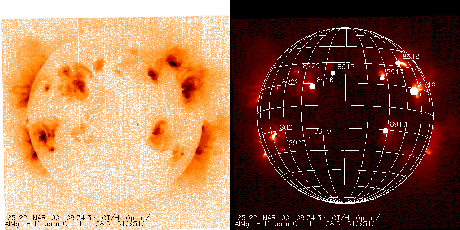
This week I took advantage of the on-going Max Millennium Campaign #6 to learn how to predict which region will produce major flares. We occasionally receive alerts or warnings of imminent major flares from Big Bear Solar Observatory (BBSO), HelioSynoptics and McIntosh Squared Graphics, and others, but none were received this week, even though there were two X-class flares; unfortunately neither was observed by Yohkoh because of spacecraft night.
Although a professional flare forecaster would naturally use as comprehensive information as possible, let me concentrate on SXT data here. First, I would like to ask you which region in the SXT image shown below (click to enlarge) produced one of the X-class flares 10 hours later. There are many bright active regions in this image, and their ID's (NOAA active region numbers) are indicated in the right panel.

The answer is found in the following movie that also includes the images after the X-class flare (as indicated in the GOES light curves).

Although AR 8918 showed some activity, AR 8910 was responsible for not only the X-class flare (18:45 UT) but also other smaller ones. But it is hard to predict this, purely on the basis of the X-ray images. The images do not show clear sigmoids (S-shaped regions), to which some people enthusiastically attribute the occurrences of (eruptive) flares (see, e.g., a previous nugget). To this author, the "sigmoidicity" is always a matter of subjectivity, and a sigmoid region is hard to identify anyway, when the region moves away from the central meridian.
For the campaigne, Lyndsay Fletcher and I agreed every morning that we stick to AR 8910, which was often the brightest on the Sun. This judgment was partially affected by the campaigners' preference to stay on a same region, but also based on our experience that a region bright in X-rays tends to be flare-productive. We also looked at the NOAA event report, which is maintained by professional forecasters, to learn the flaing history of the regions, since we may expect the recurrence of flares in the same regions. The main source of information for this report may be H-alpha patrol images as taken at SOON sites, and thus the identification of limb flares may be somewhat tricky. X-ray/EUV data would be better for limb flares.
Yohkoh's data coverage is not regular, primarily because of spacecraft night, and this can be supplemented by SoHO/EIT images, which have regular cadence. Even then I find our flare prediction rather restricted as follows.
It would be nice if the improvement of flare prediction comes along, parallel with the improvement of our physics-based (i.e., not cartoon-based) understanding of how a flare is triggered. The mechanism must be of magnetic origin. It is often argued but not convincingly shown that emerging flux and shear can cause a flare. The reason we repeat the same discussion over and over may be that we still do not have high-quality full-disk (and vector) magnetograms at high cadence. As expected, it is hard to interpret magnetogram data for regions close to the limb. So it would be ideal if we could monitor the magnetic evolution of the Sun from different directions. Until this materializes, there will still be much room for scientists to discuss possible signatures in different wavelengths that appear to them to lead to a flare.
24 March 2000
N. V. Nitta (nitta@lmsal.com)